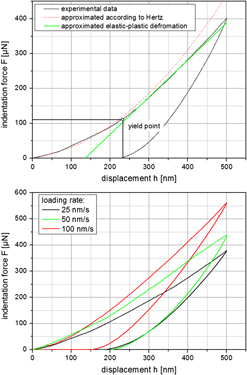Crossref Citations
This article has been cited by the following publications. This list is generated based on data provided by
Crossref.
Romeis, S.
Paul, J.
Ziener, M.
and
Peukert, W.
2012.
A novel apparatus for in situ compression of submicron structures and particles in a high resolution SEM.
Review of Scientific Instruments,
Vol. 83,
Issue. 9,
Schilde, Carsten
Hanisch, Christian
Naumann, Dennis
Beierle, Theresa
and
Kwade, Arno
2013.
A novel way to vary the structure of precipitated silica and calcium carbonate aggregates in a wide range by using grinding media during the precipitation process.
Chemical Engineering Science,
Vol. 94,
Issue. ,
p.
127.
Strege, S.
Weuster, A.
Zetzener, H.
Brendel, L.
Kwade, A.
and
Wolf, D. E.
2014.
Approach to structural anisotropy in compacted cohesive powder.
Granular Matter,
Vol. 16,
Issue. 3,
p.
401.
Schilde, Carsten
Burmeister, Christine Friederike
and
Kwade, Arno
2014.
Measurement and simulation of micromechanical properties of nanostructured aggregates via nanoindentation and DEM-simulation.
Powder Technology,
Vol. 259,
Issue. ,
p.
1.
Barth, Nina
Schilde, Carsten
and
Kwade, Arno
2014.
Influence of electrostatic particle interactions on the properties of particulate coatings of titanium dioxide.
Journal of Colloid and Interface Science,
Vol. 420,
Issue. ,
p.
80.
Breitung‐Faes, Sandra
and
Kwade, Arno
2014.
Use of an Enhanced Stress Model for the Optimization of Wet Stirred Media Milling Processes.
Chemical Engineering & Technology,
Vol. 37,
Issue. 5,
p.
819.
Hossain, Mohammad
Faisal, Hasan
and
Tarefder, Rafiqul
2014.
Asphalt Pavements.
p.
1375.
Paulick, M.
Morgeneyer, M.
and
Kwade, A.
2015.
Review on the influence of elastic particle properties on DEM simulation results.
Powder Technology,
Vol. 283,
Issue. ,
p.
66.
Barth, Nina
Zimmermann, Mandy
Becker, Andre Erek
Graumann, Tobias
Garnweitner, Georg
and
Kwade, Arno
2015.
Influence of TiO2 nanoparticle synthesis on the properties of thin coatings.
Thin Solid Films,
Vol. 574,
Issue. ,
p.
20.
Schilde, Carsten
and
Kwade, Arno
2015.
Colloid Process Engineering.
p.
205.
Hossain, Mohammad I.
Faisal, Hasan M.
and
Tarefder, Rafiqul A.
2015.
Characterisation and modelling of vapour-conditioned asphalt binders using nanoindentation.
International Journal of Pavement Engineering,
Vol. 16,
Issue. 5,
p.
382.
Banerjee, Joyita
Panwar, Ajay S.
Mukhopadhyay, Kingsuk
Saxena, A. K.
and
Bhattacharyya, Arup R.
2015.
Deagglomeration of multi-walled carbon nanotubes via an organic modifier: structure and mechanism.
Physical Chemistry Chemical Physics,
Vol. 17,
Issue. 38,
p.
25365.
Weuster, A.
Strege, S.
Brendel, L.
Zetzener, H.
Wolf, D. E.
and
Kwade, A.
2015.
Shear flow of cohesive powders with contact crystallization: experiment, model and calibration.
Granular Matter,
Vol. 17,
Issue. 2,
p.
271.
Schilde, Carsten
Schlömann, Mario
Overbeck, Achim
Linke, Stefan
and
Kwade, Arno
2015.
Thermal, mechanical and electrical properties of highly loaded CNT-epoxy composites – A model for the electric conductivity.
Composites Science and Technology,
Vol. 117,
Issue. ,
p.
183.
Han, Chung-Souk
Sanei, Seyed H.R.
and
Alisafaei, Farid
2016.
On the origin of indentation size effects and depth dependent mechanical properties of elastic polymers.
Journal of Polymer Engineering,
Vol. 36,
Issue. 1,
p.
103.
Zellmer, Sabrina
Lindenau, Maylin
Michel, Stephanie
Garnweitner, Georg
and
Schilde, Carsten
2016.
Influence of surface modification on structure formation and micromechanical properties of spray-dried silica aggregates.
Journal of Colloid and Interface Science,
Vol. 464,
Issue. ,
p.
183.
Hossain, Mohammad I.
Faisal, Hasan M.
and
Tarefder, Rafiqul A.
2016.
Determining effects of moisture in mastic materials using nanoindentation.
Materials and Structures,
Vol. 49,
Issue. 3,
p.
1079.
Liu, Daoyin
van Wachem, Berend G.M.
Mudde, Robert F.
Chen, Xiaoping
and
van Ommen, J. Ruud
2016.
Characterization of fluidized nanoparticle agglomerates by using adhesive CFD-DEM simulation.
Powder Technology,
Vol. 304,
Issue. ,
p.
198.
Liu, Daoyin
van Wachem, Berend G. M.
Mudde, Robert F.
Chen, Xiaoping
and
van Ommen, J. Ruud
2016.
An adhesive CFD‐DEM model for simulating nanoparticle agglomerate fluidization.
AIChE Journal,
Vol. 62,
Issue. 7,
p.
2259.
Schilde, C.
Gothsch, T.
Beinert, S.
and
Kwade, A.
2016.
Microsystems for Pharmatechnology.
p.
197.



